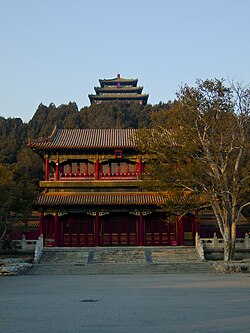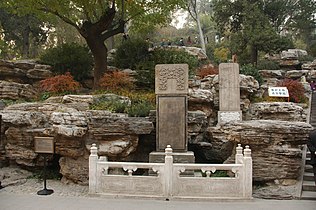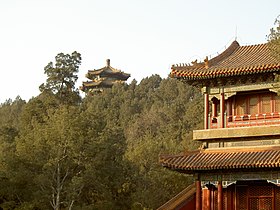Jingshan Park
You can help expand this article with text translated from the corresponding article in Chinese. (November 2016) Click [show] for important translation instructions.
|
| Jingshan Park | |
|---|---|
| 景山公园 | |
 One of the peaks of Jingshan | |
| Type | Urban park |
| Location | Beijing, China |
| Coordinates | 39°55′25″N 116°23′26″E / 39.92361°N 116.39056°E |
| Area | 23 ha (57 acres) |
| Created | 11th century (built the hill) 1179 (as imperial garden) 1267 (rebuilt) 1651 (rebuilt) 1928 (as public park) |
| Jingshan | ||
|---|---|---|
Hanyu Pinyin Méishān | | |
| Wade–Giles | Mei-shan | |
Jingshan Park is an imperial park covering 23 hectares (57 acres) immediately north of the
History

Jingshan's history dates to the Liao and Jin dynasties, almost a thousand years ago.[5] The 45.7-meter (150 ft) high artificial hill was constructed in the Yongle era of the Ming dynasty entirely from the soil excavated in forming the moats of the Imperial Palace and nearby canals. All of this material was moved by manual labor and animal power. Jingshan consists of five individual peaks, and on the top of each peak there lies an elaborate pavilion. These pavilions were used by officials for gathering and leisure purposes. These five peaks also draw the approximate historical axis of central Beijing.
The dictates of
The Chongzhen Emperor, the last ruler of the Ming dynasty, committed suicide by hanging himself from a tree in Jingshan in 1644 after Beijing fell to Li Zicheng's rebel forces.
Relationship with the Forbidden City
Jingshan Hill is separated from the
The street addresses of both the Forbidden City and Jingshan Park are on New Jingshan Street. Jingshan Park is now a popular place for people to gather and socialize. One can often find elderly folks dancing, singing opera and doing other cultural activities, such as
Access
The park has four entrances, one in each of the cardinal directions, but only three are currently open to the public. The south entrance is located across Jingshan Front Street from the Forbidden City and is accessible by
Gallery
|
See also
- Jingshan (disambiguation)
- Zuihuai
- List of Beijing landmarks
- Zhongnanhai
- Summer Palace
- Old Summer Palace
References
- ^ "Jingshan Park". Travelchinaguide.com. Retrieved 2012-03-02.
- ^ Whiteman, Stephen. "From Upper Camp to Mountain Estate: Recovering Historical Narratives in Qing Imperial Landscapes", pp. 14 ff. Studies in the History of Gardens & Designed Landscapes: An International Quarterly. Taylor & Francis, 2013. Accessed 16 November 2013.
- Chinese gardening, referring to "the scenic and emotional focal points in a garden’s design, the sites of richest sensory experience".[2]
- ^ a b Cultural China. "Jinshan Park in Beijing Archived 2013-05-12 at the Wayback Machine". Accessed 16 November 2013.
- ^ Beijing Jingshan Park Official Website Archived 2013-06-05 at the Wayback Machine Accessed 2013-06-18
- ^ The China Guide. "Jingshan Park Archived 2016-04-13 at the Wayback Machine". Accessed 16 November 2013.
External links
 Media related to Jingshan Park at Wikimedia Commons
Media related to Jingshan Park at Wikimedia Commons
















